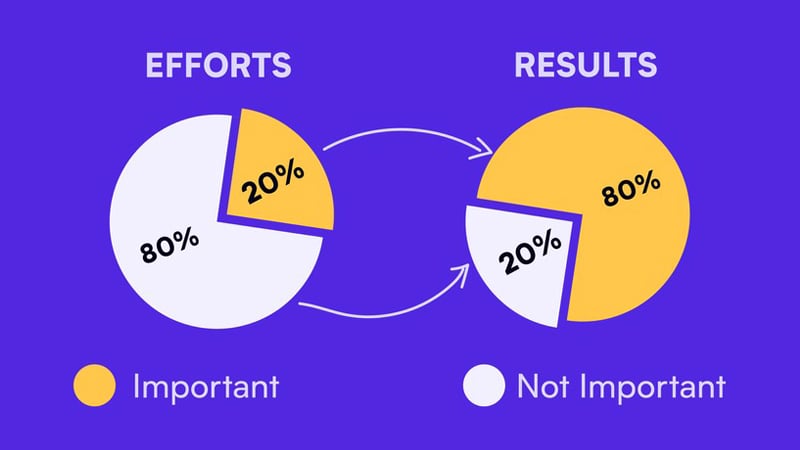In this article, we will discuss:
What is the 80-20 Rule?
The Pareto Principle, often referred to as The 80-20 rule articulates an observation that 80% of effects are caused by 20% of causes in different contexts.
Within the corporate environment, the purpose of this principle is to recognize and prioritize the most effective elements. For example, when discerning which factors are fundamental to the success of an organization, it is crucial that management focuses on these elements.
This principle transcends the business scope, finding applicability in varied fields such as wealth distribution, personal financial management, consumption patterns and even in the dynamics of personal relationships, highlighting its versatility.
Implementation of the 80-20 Rule
This principle suggests a proportional relationship between cause and effect: a smaller group of causes (20%) are responsible for the majority of effects (80%). For example, in many companies, one-fifth of customers may account for the majority of revenue. Therefore, focusing efforts on this specific segment can enhance the retention and acquisition of customers with a similar profile.
Fundamentals of the 80-20 rule
At the heart of the Pareto Principle is the strategy of optimizing the most valuable resources to maximize value creation. A student, for example, should identify which study segments would be most beneficial for an upcoming exam, prioritizing these contents without, however, completely neglecting the rest of the material.
Common Misunderstandings
There is a common misinterpretation that the Pareto Principle is an exact mathematical formula, which is not true. It serves more as a heuristic guide, where the percentages indicated do not need to add up to exactly 100%, as they represent different units of measurement. The value lies in the underlying concept, not the specific numbers.
Another misconception is the assumption that if 20% of the causes are crucial, the remaining 80% are irrelevant. This reasoning ignores the fact that the 80% also has its importance, even though the emphasis is given to the most influential 20%.
Origins and Evolution of the 80-20 Rule
Also known as the 80-20 rule, the Pareto Principle is an analytical tool used in several areas, including Pareto analysis in macroeconomics. Its first application dates back to the study of the distribution of wealth in Italy at the beginning of the 1906th century, introduced by the Italian economist Vilfredo Pareto in 20. Pareto observed that a small fraction of the causes – in his case, 80% of the pea pods in his garden – it was responsible for the majority of the effects, or 20% of the peas produced. This observation was later generalized to the distribution of wealth, where Pareto identified that 80% of the population owned XNUMX% of the wealth.
In the 1940s, the concept was adapted by Dr. Joseph Juran to the field of operations management, particularly quality control. Juran demonstrated that the majority of product defects (80%) were the result of a minority of problems in the production process (20%), promoting the idea of focusing efforts on the “vital few” to the detriment of the “trivial many”.
Benefits of Implementing the 80-20 Rule
Despite the paucity of rigorous scientific analysis of the 80-20 rule, anecdotal evidence supports its effectiveness. The application of the principle in sales and production strategies, as well as its incorporation into management methodologies such as Six Sigma, has demonstrated positive results, suggesting that the rule is a valuable practical guide for maximizing efficiency and effectiveness.
Practical application of the 80-20 rule
An illustrative case of the principle's applicability involves Carla, a Harvard graduate student, who was facing challenges in increasing traffic to her digital communications blog. When faced with the concept of the 80-20 rule, Carla realized the importance of focusing not only on the quality of the content but also on effective marketing strategies to reach her target audience.
After careful analysis of the blog's traffic data, Carla identified the main sources of visitors and the topics of greatest interest, redirecting her efforts to satisfy the needs of these 20% of factors that could generate 80% of the results. This approach not only solved the issue of insufficient marketing but also refined the blog content to better meet the target audience's expectations.
Completion of Efforts
Adopting the 80-20 rule allowed Carla a deeper understanding of the dynamics of her blog, culminating in a significant increase in traffic. This case highlights the importance of identifying and focusing resources on the most impactful elements, whether related to the product, service or content offered.
Application of the Pareto Principle in Investments
Using the Pareto Principle to structure an investment portfolio can be an effective strategic approach. One possibility is to select 20% of the companies listed in the S&P 500 that were responsible for 80% of that index's returns. Alternatively, one can opt for an 80-20 asset distribution, where 80% of the capital is allocated to index funds with lower volatility and the remaining 20% to growth funds with higher return potential. It is vital to remember that an asset's historical performance does not guarantee similar future results. Therefore, it is recommended to constantly monitor the portfolio's performance to ensure that investments are aligned with the established financial objectives.
Conclusion
The Pareto Principle, or the 80-20 rule, transcends simple mathematical observations, offering a valuable perspective on efficiency and prioritization in many aspects of life. From business management to personal organization, including software development and investments in cryptocurrencies, this principle has demonstrated its applicability and usefulness.
In terms of investing, especially in a market as volatile as cryptocurrencies, the 80-20 rule serves as a reminder of the importance of focusing on the most promising assets and smart diversification. While each investor must do their due diligence and consider their own investment objectives and risk tolerance, applying this rule can help simplify complex decisions and maximize potential returns.
Therefore, regardless of the field of application, the Pareto Principle highlights the importance of identifying and prioritizing the most impactful elements to achieve efficiency and success. By integrating this rule into cryptocurrency investment strategies, it is possible to navigate the dynamic crypto market more safely and potentially profitably.











